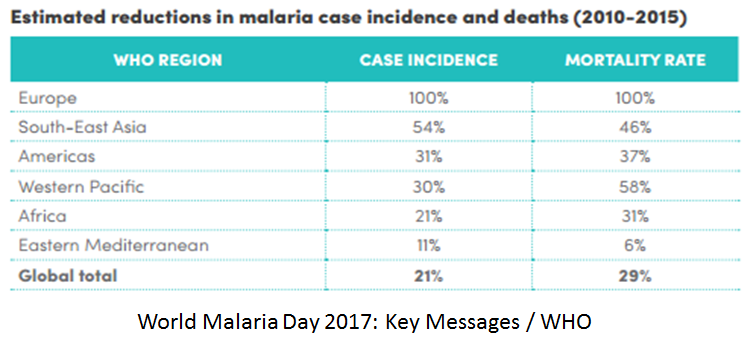World Malaria Day: Let's "End Malaria for Good"
On World Malaria Day, the world focuses on how to eliminate malaria once and for all.
On April 25, 2017, the world celebrates World Malaria Day, a day where we reflect on advancements that have been made in the global fight against a mosquito-borne illness that remains a public health concern, especially in areas that are hit hardest, such as sub-Saharan Africa. The theme this year has ambitiously been named “End Malaria for Good,” a goal that everyone can get on board with.
The good news is, the rate of new cases has fallen by 21% on a global scale between 2010 and 2015. Furthermore, malaria-associated death rates have also fallen by 29% during that period. Even sub-Saharan Africa, a region that holds a staggering 90% of the global malaria burden, has seen incidence rates fall by 21% and death rates fall by 31%, according to the World Malaria Report 2016. In fact, the World Health Organization (WHO) reports that a whopping 663 million cases have been averted since 2001.

Although advancements have been made, WHO stresses that progress needs to be “greatly accelerated.” To control, and eventually eliminate malaria, ambitious targets must be set. Luckily, in May 2015, the World Health Assembly approved WHO’s Global Technical Strategy for Malaria 2016-2030, a blueprint that aims to reduce incidence and death rates by 40% between 2015 and 2020. However, WHO notes that “less than half of the world’s 91 countries with malaria transmission are on track to achieve these milestones.” On the bright side, in WHO’s “Eliminating Malaria” report, 21 countries were identified to potentially achieve “one year of zero indigenous cases of malaria by 2020.”
The WHO-Director-General has already certified the following 7 countries as having “eliminated” malaria (countries that have had at least 3 consecutive years of zero locally-acquired cases) in recent years: United Arab Emirates (2007), Morocco (2010), Turkmenistan (2010), Armenia (2011), Maldives (2015), Sri Lanka (2016) and Kyrgyzstan (2016).
Within the theme for World Malaria Day, there will be a specific focus on prevention, particularly since over the past 17 years, prevention strategies have played a pivotal role in reducing the number of newly-acquired infections. So, what has been working best? WHO reports that long-lasting insecticide-treated nets “have the greatest impact, accounting for an estimated 69% of all cases prevented through control tools.” WHO recommends that individuals at highest risk for malaria (such as those living in regions with active malaria transmission or pregnant women) should sleep under these nets every night to prevent infection. Over the last decade, use of these nets has “increased substantially” in sub-Saharan Africa; in fact, such prevention measures may be responsible for the decline in incidence noted in the World Malaria Report. Another strong preventive measure that can be taken is spraying insecticides on indoor walls and ceilings “where malaria-carrying mosquitoes are likely to rest after biting household occupants,” WHO reports. Indoor residual spraying (IRS) is most effective when “at least 80% of homes in targeted areas are sprayed,” and the protection lasts from 3 to 6 months. According to WHO, in 2015, IRS protected a whopping 106 million individuals from malaria.
Although some protective measures do, indeed, seem to be working, there are many gaps noted by WHO in prevention coverage. For example, they note that almost half of individuals in sub-Saharan Africa, individuals at increased risk of infection (43%), had not been protected by insecticide-treated nets or IRS in 2015. Furthermore, WHO noted that in 20 African countries, 69% of pregnant women “did not have access to the recommended 3 or more doses of preventive treatment.” Although some countries have updated their prevention policies, uptake in actually implementing these targeted prevention approaches have been slow. For example, WHO mentions that although there is preventive treatment available for infants, which is not only safe, but is also cost-effective, the treatment is only currently being implemented in Sierra Leone.
Despite these notable gaps, advances continue to be made in the fight against malaria. For example, for the first time, a research team has reported on the safety and effectiveness of a Plasmodium falciparum sporozoite vaccine; another team has reported on the early trials of a “new, long-lasting antimalarial,” dubbed DSM265, which may be a potential single-dose cure for the disease. In addition, the National Institute of Allergy and Infectious Diseases (NIAID) has recently announced that they will provide $9 million in first-year funding for seven malaria research centers around the world.
According to the press release, “The awards fund three new and four existing centers that work in 14 countries of Africa, Asia, and Latin America.” Furthermore, another huge announcement has been made by the WHO Regional Office for Africa stating that Ghana, Kenya, and Malawi are going to participate in a “WHO-coordinated pilot implementation programme that will make the world’s first malaria vaccine available in selected areas, beginning in 2018.”
